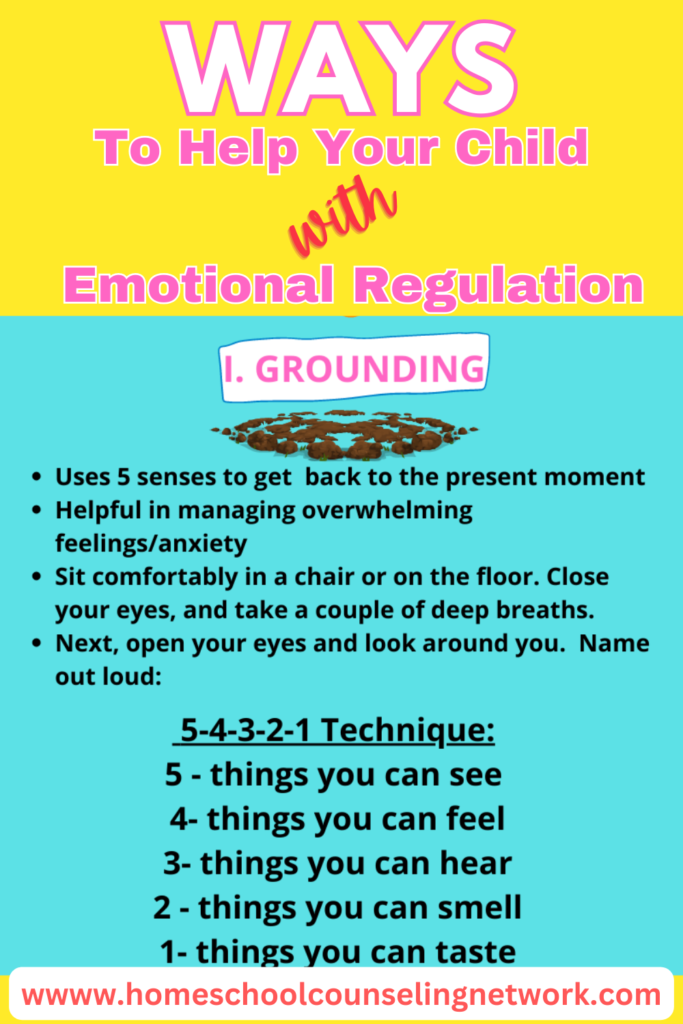Ground Your Kids To Help Them Manage BIG Feelings

In previous blog posts, we talked about the emotional roller coaster of feelings and introduced you to the topic of emotional regulation, including what it is and what it is not. We discussed the purpose and function of feelings, and the importance of making friends with feelings, and introduced you to The Power of the Pause.
We also introduced you to an eight-part series where we will explore Eight Ways To Help Your Child Regulate Emotions.
Today, we will explore the first technique for helping your child handle BIG feelings – grounding.
Getting Grounded
Being grounded. Depending on the content, being grounded can be a good thing or a bad thing.
When I was a kid, being grounded did not have the same meaning for me as it does today now that I am a helping professional and a parent of a child who struggles with anxiety.
When I was growing up, grounding was something to avoid. It meant you had crossed a line (or stepped out of line) somewhere and your parents were applying consequences to help you correct your behavior.
Once I became an adult, and later a therapist and even later a parent, being grounded took on an entirely new and positive connotation.
Grounding Explained
Grounding is a practice that can help you pull away from flashbacks, unwanted memories, and negative or challenging emotions.
Grounding techniques are exercises that may help you refocus on the present moment to distract yourself from anxious feelings.
Grounding Techniques: Exercises for Anxiety, PTSD, and More (healthline.com)
There are multiple types of grounding exercises. Today, we are going to cover the 5-4-3-2-1 Technique.
Purpose of Grounding
When we are in the throes of anxiety, we can feel incredibly disconnected from the world around us. Caught up in the intense physical sensations going on inside our bodies (racing heart, rapid breathing, tight chest), and our minds (reliving bad experiences, and negative thoughts).
Mental grounding techniques help distract us by pulling our awareness away from our internal thoughts and physical sensations to the world outside of our minds and bodies.

Engaging all five of our senses as we practice this grounding exercise helps us redirect our thoughts and feelings to the present moment. Remember the fight or flight response our amygdala is so well known for?
Grounding exercises help us tell our amygdala to chill out for a minute by calming our bodies and communicating to our brains that we are in no real danger. They help us regain control, provide immediate relief, and can be practiced anywhere.
Coming Up
In upcoming blog posts, we will continue with part two of our eight-part series Eight Ways To Help Your Child Regulate Emotions. We will explore how sounds can soothe.
Keep In Touch
Be sure you do not miss a blog post by signing up for our email list, liking our Facebook, Instagram, Linked In, or Pinterest pages, or subscribing to our YouTube channel.
Like what you see here? Sharing is caring!
Blessings,
Kimberly Bennett, LPC
IOH Mom
Founder/CEO, It’s Only Homeschooling
Founder/CEO, The Homeschool Counseling Network

This website is not a professional counseling website and nothing here should be construed as professional counseling advice. Although Kimberly Bennett, LPC is a Licensed Professional Counselor, she is not your counselor, and no counselor-client relationship is established unless she has signed an agreement with you. All information provided through this website is for informational and educational purposes only.